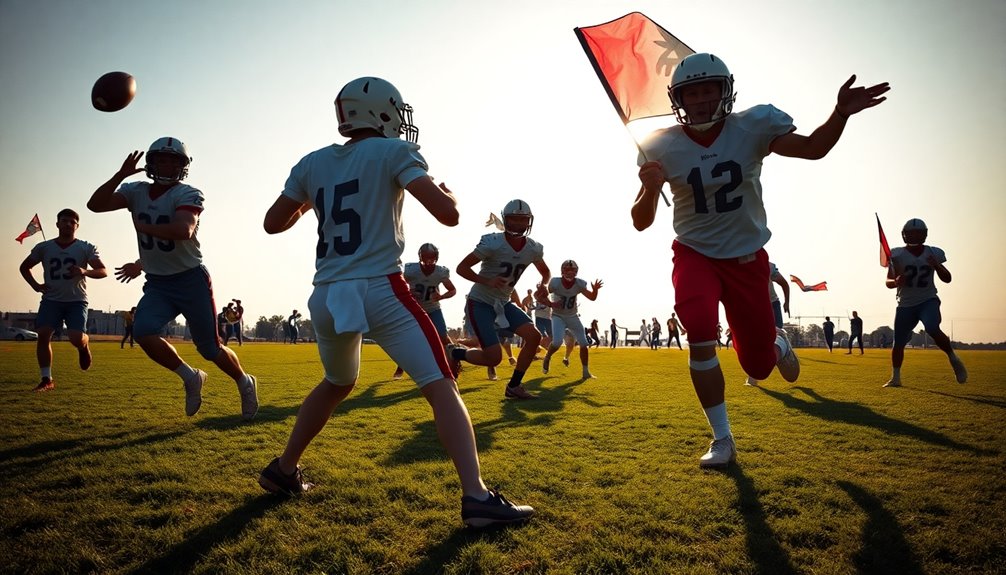
7v7 Flag Football Plays: Creative Strategies for Success
January 25, 2025For success in 7v7 flag football, you need a mix of creativity and strategy. Start with a diverse playbook that includes 8-10 effective plays. Use formations like trips or bunch to create confusion and mismatches against the defense. Focus on key routes such as slants and crosses to exploit weaknesses. Incorporating quick passes and trick plays keeps your opponents guessing. Don't forget the importance of communication; it builds trust and enhances teamwork. With the right practices, you'll enhance your team's performance and adaptability. There's so much more to explore about optimizing your play strategy.
Importance of Flag Football Plays
In flag football, effective plays are essential for unblocking your team's offensive potential. A well-structured playbook with 8-10 varied plays keeps your squad engaged and ready to execute under pressure.
By incorporating a mix of short and long yardage plays, you'll keep defenses guessing, preventing them from over-relying on a single strategy. Additionally, incorporating agility drills can enhance players' quick directional changes, making them more effective during these plays.
Utilizing key flag football routes—like slants, posts, and crosses—can greatly enhance your ability to advance the ball. These routes are designed to exploit defensive weaknesses, creating mismatches that can lead to scoring opportunities.
Additionally, don't underestimate the power of creative play designs. Strategies like the Double Switch and Mesh Concept can confuse defenders, opening up lanes for successful plays. Understanding the importance of player conduct can also contribute to maintaining team morale and cohesion during intense match situations.
Understanding Flag Football Formations
Mastering flag football plays is only part of the equation; understanding formations can considerably elevate your game. Flag football formations are essential arrangements of players at the line of scrimmage, designed to optimize spacing and prevent crowding on the field.
By utilizing formations like the 3×2 or bunch formations, you can create natural rubs that confuse defenders and open up opportunities for your offense. Adapting these formations to meet your team's strategic needs, whether you're playing 5 on 5 or 7 on 7, is vital. Effective formations allow your offense to execute various routes, making it easier to create mismatches against defenders. When you keep your opponents guessing, you enhance your scoring chances and overall team performance. Additionally, employing a 2-3-1 formation can provide a balanced structure that supports both defense and offense.
Moreover, incorporating a variety of formations throughout the game maintains unpredictability, which is key to outsmarting your opponents. The better you understand and implement different flag football formations, the more successful your offense will be. Additionally, understanding team formations can help you make timely adjustments to maximize your offensive effectiveness. This adaptability is crucial, as formation flexibility allows teams to respond effectively to changing dynamics during the game.
Key Routes in Flag Football
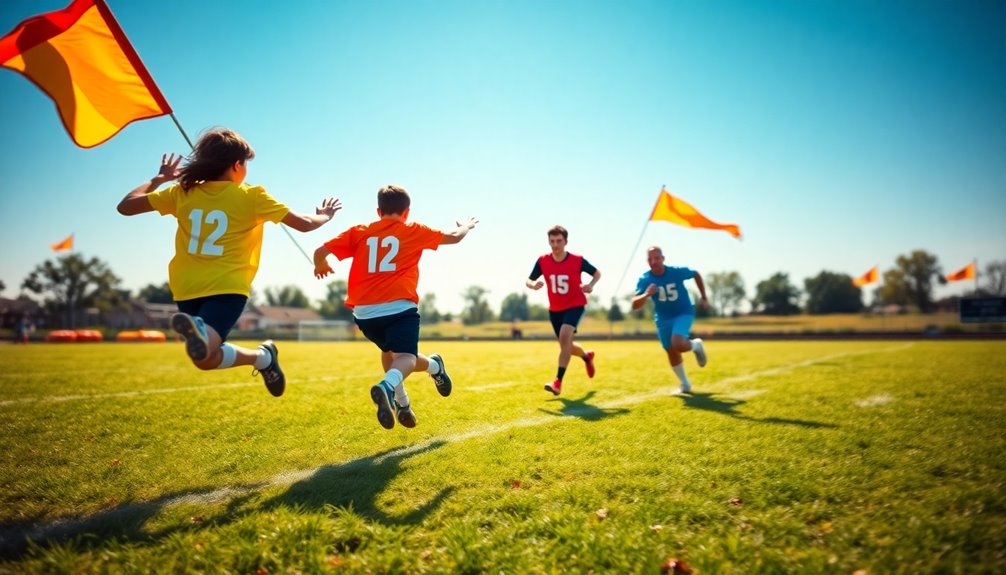
Understanding key routes in flag football is vital for any player looking to enhance their game on the field. Mastering these routes can greatly improve your effectiveness as a receiver.
The Hitch route is a fundamental play where you sprint straight for about seven yards, then pivot back sharply. This creates an excellent opportunity for a quick pass and immediate yards. Practicing passing accuracy can significantly enhance the effectiveness of this route. Additionally, developing technical abilities such as precise footwork can further improve your performance on this route.
The Slant route involves running forward, then making a 45-degree cut, which helps shake off defenders and pairs well with Out routes for added effectiveness. An Out route requires you to make a 90-degree cut after a set distance, perfect for sideline plays and quick completions.
Another important route is the Post route, where you cut toward the center of the field after a forward run, making it a reliable option for critical yardage in tough situations.
For more advanced maneuvers, the Stop and Go route involves a sudden stop followed by a sprint, effectively confusing defenders and opening up lanes for potential big plays.
Familiarizing yourself with these key routes will elevate your performance in flag football. Additionally, understanding technical skills is crucial for executing these routes effectively.
Offensive Play Structures Explained
Utilizing effective offensive play structures is essential for flag football teams aiming to outsmart their opponents. These structures leverage various formations like trips, bunch, and spread to create mismatches and open passing lanes for your quarterback. Here's how to maximize your offensive potential:
- Focus on Routes: Incorporate a mix of routes, such as slants and posts. This keeps defenders guessing and creates opportunities for your receivers.
- Prioritize Execution: The success of your offensive plays hinges on precise execution. Timing and proper spacing among receivers are vital for a successful play.
- Embrace Adaptability: Be ready to adjust your plays based on the defensive formations you face. Flexibility allows you to exploit weaknesses in the opposing defense.
Integrating quick, short passes can help maintain possession while showcasing your receivers' athleticism. Additionally, understanding midfield dynamics can enhance your offensive strategy by improving coordination among players.
Strategies for 5 on 5 vs. 7 on 7
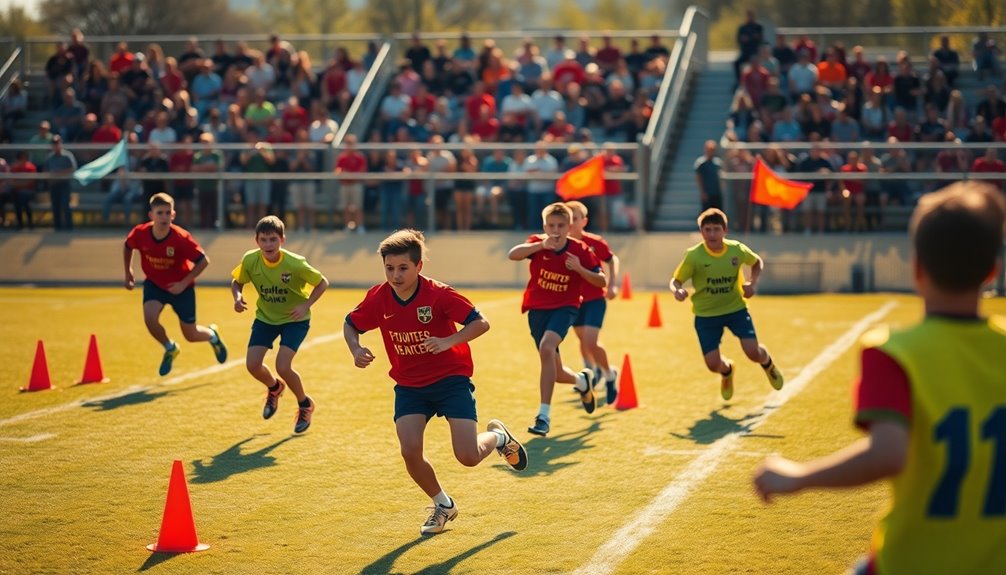
When it comes to flag football, your approach can vary greatly between 5 on 5 and 7 on 7 formats. In 5 on 5, you'll typically rely on a straightforward strategy, featuring one quarterback, one center, and three receivers. Your focus should be on quick decision-making and short passing plays to maintain possession while exploiting defensive gaps. Teamwork enhancement exercises are crucial for developing communication and coordination among your players. Additionally, incorporating endurance training methods can help improve players' stamina for sustained performance throughout the game.
Keep your formations simple to maximize efficiency.
In contrast, the 7 on 7 format introduces more complexity with one quarterback, one center, and four receivers. This allows you to develop diverse offensive strategies and utilize additional roles like linemen, enhancing protection and enabling running plays. Here, you can implement creative plays with formations like Trips or Bunch, creating mismatches and confusion among defenders. The greater number of players in 7 on 7 also means you can take advantage of motion and trick plays, adding depth to your offensive game. Additionally, incorporating agility drills can help improve players' quickness and decision-making under pressure.
You'll want to craft intricate route combinations, keeping the defense guessing. Overall, mastering the nuances of both formats will help you elevate your team's performance, so adapt your strategies accordingly and make the most of the unique opportunities each format presents.
Effective Communication on the Field
Effective communication on the field directly impacts your team's ability to execute plays successfully. When all players understand their roles and responsibilities, confusion decreases, and performance improves.
Here are three key strategies for effective communication:
- Utilize Verbal Cues and Hand Signals: In fast-paced situations, clear verbal cues and hand signals can make all the difference. Practice these during training so everyone knows what to expect.
- Establish a Common Language: Create a shared terminology for plays and routes. This common language helps players connect and enhances teamwork, allowing for seamless execution during games. Effective communication and strong team dynamics are crucial for optimizing performance. Additionally, fostering cultural exchange among players can further enhance understanding and collaboration.
- Encourage Open Dialogue: Foster an environment where players feel comfortable expressing concerns or suggesting adjustments. Open dialogue builds trust and improves overall teamwork, which is vital for success.
Regular practice of these communication strategies reinforces their importance and builds on-field chemistry. Additionally, understanding team dynamics is essential for effective communication and collaboration among players.
When players engage effectively, they enhance their ability to adapt during games, making it easier to execute plays smoothly.
Safety Regulations in Flag Football
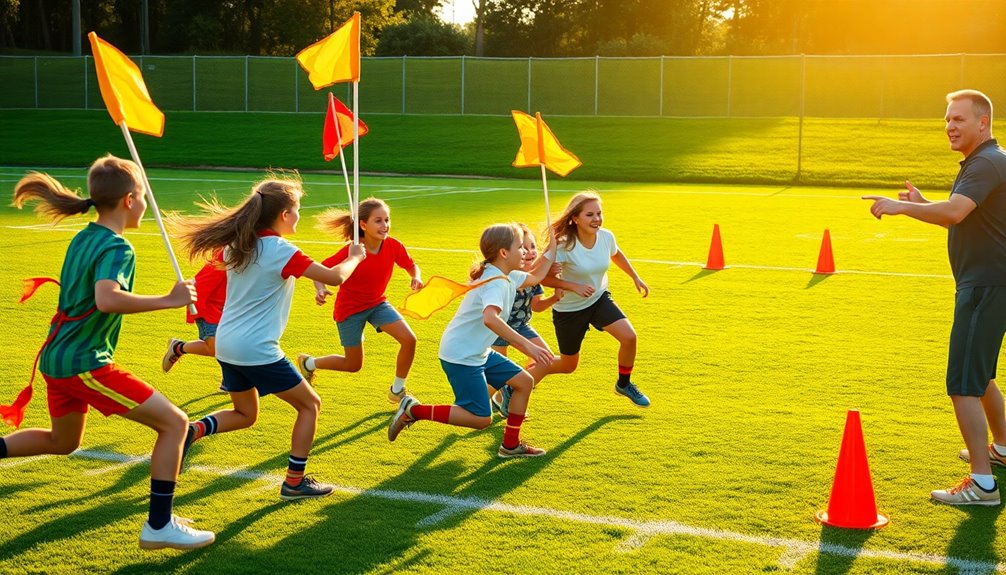
In flag football, non-contact gameplay rules are vital for keeping everyone safe on the field.
You'll find that player safety measures, like mandatory flag belts and age-specific player limits, are strictly enforced to reduce injury risks.
Each league may have its own specific regulations, so it's important to familiarize yourself with them to guarantee a safe and enjoyable game.
Non-Contact Gameplay Rules
Flag football emphasizes safety through its non-contact gameplay rules, making it accessible for players of all ages. By prohibiting tackling, the game guarantees that players can focus on skill development and strategy without the risk of injury.
Here are some key aspects of non-contact gameplay:
- Flag Removal: To stop a play, players must remove the flag from the ball carrier, fostering a non-contact environment that enhances safety.
- Pass Eligibility: All players are eligible to receive passes, which adds variety to gameplay while preventing aggressive physical confrontations.
- Quarterback Restrictions: The quarterback can't run with the ball to gain yardage, promoting strategic passing plays that keep the game dynamic and engaging.
Additionally, direct handoffs must occur behind the line of scrimmage, maintaining a structured play format that emphasizes skill over brute force.
Remember that safety regulations can vary by league, so it's vital for players and coaches to familiarize themselves with specific guidelines. Doing so guarantees compliance and protects all participants, allowing everyone to enjoy the game safely and effectively.
Player Safety Measures
Guaranteeing player safety is fundamental in flag football, where non-contact rules are designed to minimize injury risks. Since it's a non-contact sport, tackling is prohibited, allowing players to focus on skillful flag pulling techniques instead.
To enhance player safety, clear communication among players is significant. This minimizes confusion on the field and makes sure everyone understands their roles during plays.
Safety measures also include adhering to equipment regulations that often require the use of flags and mouthguards. These regulations are essential in protecting players during games and reducing the likelihood of injuries.
Additionally, many leagues have specific rules regarding player conduct, which prohibit aggressive play and enforce safe flag pulling techniques.
Regular safety briefings and rule reviews are important for maintaining awareness of these safety protocols. They help players understand the importance of adherence to regulations, creating a safer playing environment for everyone involved.
By prioritizing these measures, you not only promote player safety but also contribute to a positive experience for all participants in flag football.
League-Specific Regulations
Player safety remains a top priority as you navigate the specific regulations that govern flag football leagues.
Understanding these league-specific regulations guarantees compliance while prioritizing safety. Here are three key safety regulations you should keep in mind:
- Non-Contact Play: Flag football prohibits tackling and any form of physical contact. Players must focus on pulling flags instead of engaging in physical confrontations, which promotes a safer environment.
- Player Eligibility: Each league has specific guidelines regarding player eligibility. It's crucial to familiarize yourself with these rules to make certain all participants meet the necessary requirements for safety and fairness.
- Flag Attachment: Players must wear flags securely attached to their waists. This allows opponents to stop ball advancement by pulling the flags, reinforcing the non-contact nature of the game.
Coaching Tips for Flag Football
Effective coaching in flag football hinges on clear communication among team members. When everyone understands their roles and responsibilities during plays, you reduce confusion on the field, allowing for smoother execution.
Utilize a variety of offensive formations, like bunch formations and trips, to create mismatches and open passing lanes against defenders.
Incorporate practice drills that focus on route running and timing. This enhances players' abilities to execute plays effectively during games. Make sure your team practices regularly, so they can develop chemistry and improve their performance.
Regularly assess player strengths and weaknesses to tailor strategies that suit your team's unique composition. By knowing what each player excels at, you can adapt plays that maximize overall performance.
Encourage ongoing learning and adaptation by utilizing available resources, such as playbooks and coaching clinics. Staying updated on effective strategies and techniques can greatly enhance your coaching approach.
Innovative Offensive Strategies
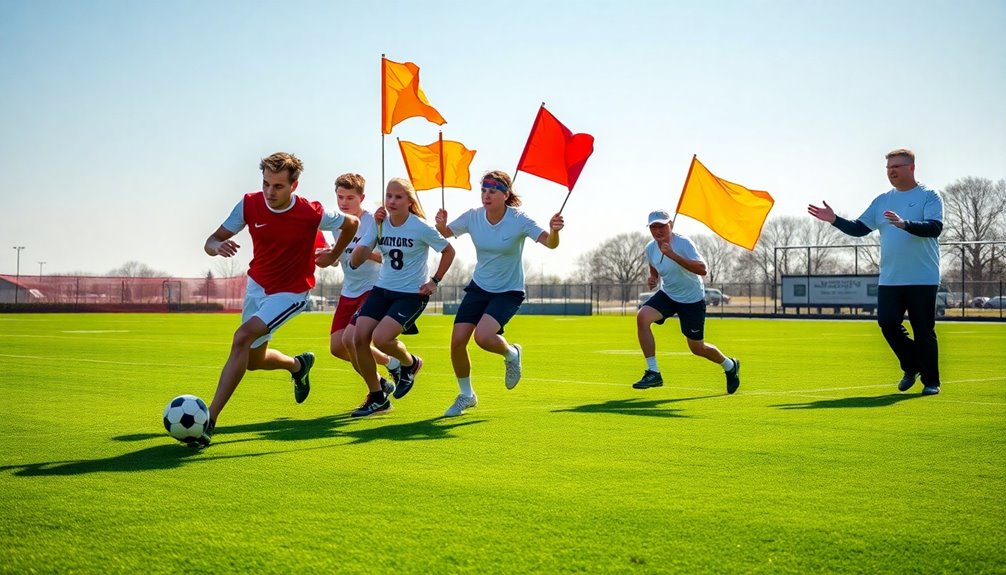
Incorporating quick pass techniques can help you maintain possession while allowing your skilled receivers to gain valuable yards after the catch.
By utilizing mismatched playmakers, you can create confusion among defenders and open up your offense.
Don't forget to integrate trick plays; they can catch your opponents off guard and exploit any defensive weaknesses.
Quick Pass Techniques
When you look to shake up your offensive strategy, quick pass techniques can really turn the tide in your favor. By focusing on quick passes, you can maintain possession while exploiting defensive weaknesses.
Here are three key strategies to implement:
- Timing Routes: Utilize timing routes to allow your receivers to gain separation swiftly. This enables you to release the ball before the defense reacts, keeping your offensive momentum alive.
- Motion Before the Snap: Incorporate motion to confuse defenses and create open passing lanes. This can lead to easy completions and enhance your chances of success.
- Accurate Passing and Quick Decision-Making: Emphasize the importance of accurate passing and quick decision-making. This minimizes the risk of turnovers and keeps your team advancing down the field.
Mismatched Playmaker Utilization
Mismatched playmaker utilization can be a game-changer in 7v7 flag football, giving your team a distinct advantage on the field. To maximize your offensive strategies, identify key playmakers on your roster, such as fast receivers or agile running backs. By designing plays that exploit their unique skills against slower or less agile defenders, you're setting up potential mismatches that can lead to big gains.
Align your playmakers against defenders who struggle with their speed or route running. This increases the likelihood of successful plays and keeps the defense on their toes.
Utilize motion before the snap to confuse defenders, making it harder for them to anticipate your players' movements. This creates favorable matchups and opens up opportunities.
Implement quick passing plays that allow your playmakers to leverage their agility and speed immediately after the catch. By quickly getting the ball into their hands, you can capitalize on their ability to gain additional yards.
Additionally, analyze the opposing team's defensive tendencies to pinpoint vulnerabilities. Tailor your offensive strategies to exploit these weaknesses effectively, ensuring your mismatched playmakers shine on the field.
Trick Play Integration
Utilizing trick plays can turn the tide in a 7v7 flag football game, catching defenses off-guard and creating unexpected scoring opportunities. By incorporating innovative strategies, you can exploit defensive weaknesses and keep opponents guessing.
Here are three effective approaches to integrating trick plays:
- Misdirection: Employ fake handoffs followed by deep passes to confuse defenders. This can lead to significant yardage gains and open opportunities for your playmakers.
- Cluster Receivers: Use formations that cluster receivers, such as bunch formations. This strategy creates natural picks and miscommunications among defenders, enhancing the effectiveness of your trick plays.
- Timing and Analysis: Perfect the timing of your plays through practice. Analyze your opponent's defensive strategies to identify ideal moments for execution, particularly when they display over-aggression or predictability.
Defensive Techniques for Flag Football
Mastering defensive techniques in flag football is vital for shutting down your opponent's offense. Start by employing a zone defense to effectively cover passing lanes, making it difficult for quick passes to connect. This approach allows you to anticipate the offensive plays better and position your defenders accordingly.
You should assign a free defender to consistently apply quarterback pressure. This disrupts the quarterback's timing and forces hurried decisions, which can lead to mistakes. Additionally, utilize blitzing techniques to overwhelm the offensive line. By increasing the chances of pulling flags before the quarterback can release the ball, you enhance your defensive effectiveness.
Clear communication among defenders is essential. It guarantees proper defensive alignment and allows for timely coverage adjustments, minimizing breakdowns in your defense.
Make sure every player understands their responsibilities and stays aware of the opponent's tendencies.
Analyzing Opponent Strategies
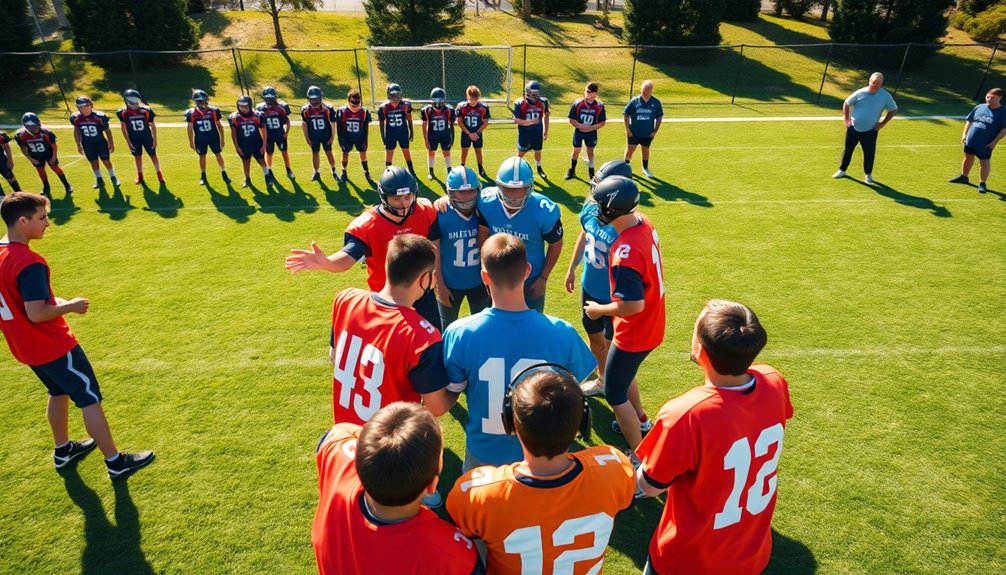
To gain an edge in your next game, you need to identify your opponent's key tendencies.
By adjusting your defensive schemes and exploiting mismatches effectively, you can neutralize their strengths.
Let's explore how analyzing these strategies can turn the tide in your favor.
Identifying Key Tendencies
Understanding your opponent's strategies is essential for success in 7v7 flag football. By identifying key tendencies, you can analyze their formations and plays to gain a competitive edge.
Here are three effective methods to help you evaluate your opponents:
- Study Game Footage: Watch previous games to pinpoint frequently used routes and formations. Pay attention to how they react to specific motions, revealing their defensive tendencies.
- Track Success Rates: Record the success rates of your opponents' plays in various situations, such as third downs or in the red zone. This data helps you anticipate their strategies during pivotal moments.
- Analyze Player Matchups: Observe which player matchups consistently favor one side. This insight can guide your play-calling, allowing you to exploit weaknesses in their defensive setup.
Utilizing statistical analysis to quantify their preferred play types—whether they lean more towards runs or passes—can further inform your game plan.
Adjusting Defensive Schemes
Once you've identified your opponent's key tendencies, it's time to adjust your defensive schemes to counter their strategies effectively.
Start by analyzing game footage to pinpoint their most frequently used plays and formations. Pay close attention to the quarterback's decision-making and passing patterns; this insight will help you predict their next moves and fine-tune your coverage.
Focus on specific player matchups that could create mismatches. Assign a free man to pressure the quarterback or to cover their best receiver, as this can disrupt their rhythm.
Utilize statistical analysis to track the success rate of your opponent's plays, allowing you to make informed defensive adjustments throughout the game.
Implement a flexible zone defense that can adapt to changing offensive strategies. This approach enables your defense to respond swiftly to the opposing team's gameplay, maintaining an edge during critical moments.
By continuously adjusting your defensive schemes based on the opponent's tendencies, you enhance your chances of success on the field.
Stay alert, analyze, and adapt—these are key elements to outsmarting your opponent and securing victory.
Exploiting Mismatches Effectively
Exploiting mismatches effectively can be a game-changer in 7v7 flag football. To take full advantage, you need to analyze your opponent's defensive personnel and identify where you can gain the upper hand.
Here's how you can do this:
- Target Weak Defenders: Identify slower defenders and place your faster receivers against them. Likewise, exploit smaller defenders by utilizing your bigger receivers to create mismatches.
- Use Motion and Shifts: Utilize motion and shifting formations to confuse the defense. This will help you draw mismatches and create advantageous matchups against defenders.
- Study Their Coverage: Understand your opponent's tendencies, whether they favor zone or man-to-man coverage. Tailor your route combinations to exploit their weaknesses, such as pairing a speedy receiver with a linebacker in man coverage for a quick gain.
Training Drills for Flag Football
To elevate your flag football team's performance, incorporating targeted training drills is crucial. Start with drills that focus on passing accuracy. Target throwing exercises can help your quarterbacks improve precision, reducing costly turnovers during games.
Next, implement flag-pulling drills that emphasize speed and technique, enabling defenders to practice effective flag retrieval while maintaining proper positioning.
Don't overlook route-running drills, which encourage sharp cuts and acceleration. These will help your receivers gain separation from defenders and enhance their timing with quarterbacks.
Teamwork exercises are important too; they promote communication and help players understand plays, allowing for seamless execution of flag football strategies during games.
Lastly, include conditioning drills that improve stamina and agility. These will guarantee your players can maintain high performance levels throughout the match.
Building a Comprehensive Playbook
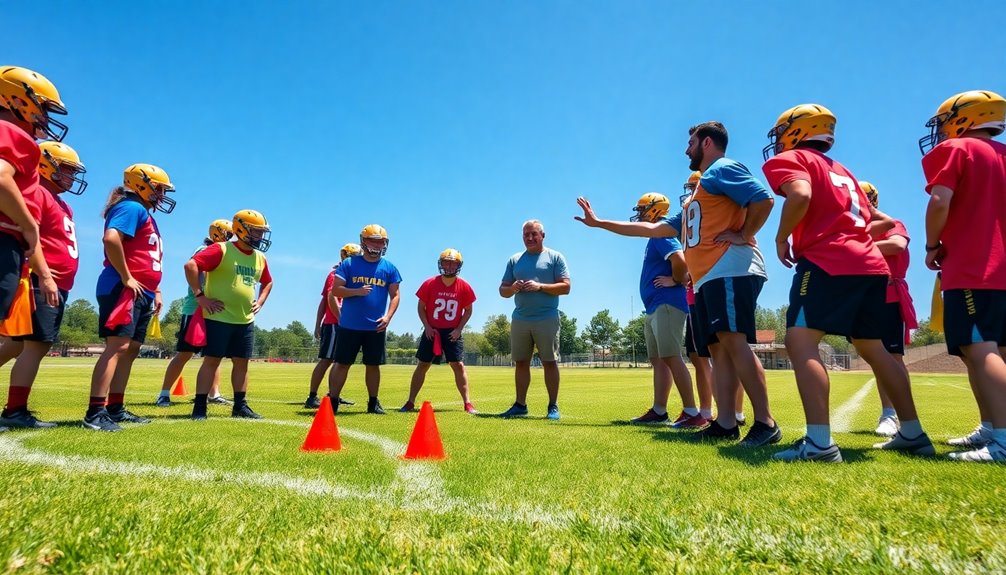
Creating an extensive playbook is essential for your flag football team's success on the field. An effective playbook not only provides strategies but also helps players understand their roles within various formations. Start by including 8-10 diverse plays to keep things manageable while offering enough variety for effective game strategies.
To build your playbook, consider the following:
- Organize by Formation: Label plays based on complexity (beginner, intermediate, advanced) to help players learn and execute effectively.
- Categorize by Yardage: Break down plays into short, medium, and long yardage categories for quick decision-making during games.
- Use Visual Aids: Incorporate diagrams and printouts for team walkthroughs, enhancing players' understanding and retention of each play.
Regularly assess and update your playbook based on team performance and players' skill development. This guarantees that your strategies remain relevant and effective, empowering your team to execute plays with confidence.
Ultimately, a well-structured playbook can be the difference between a good team and a great team on the field.
Enhancing Team Dynamics and Chemistry
Building trust among players is essential for a successful team, and it starts with effective communication.
When you share thoughts and feedback openly, everyone gains a clearer understanding of plays and strategies.
This connection not only strengthens your gameplay but also fosters a supportive environment where players can thrive together.
Building Trust Among Players
Trust among players is the backbone of any successful team, especially in 7v7 flag football. When you build trust, you enhance team dynamics, which leads to better communication and collaboration on the field.
Here are three strategies to foster that trust:
- Establish Clear Roles: Make sure everyone knows their responsibilities. When players understand their contributions, it promotes accountability and trust in each other's abilities.
- Engage in Team Bonding: Regular team workouts or social events can strengthen interpersonal relationships. These activities create a supportive environment that enhances chemistry on and off the field.
- Encourage Open Feedback: After games, facilitate discussions where everyone can express their thoughts. This openness strengthens relationships and fosters a sense of belonging, making players feel valued and heard.
Consistent practice is essential, too. As you spend time together, you'll develop a deeper understanding of each other's playing styles and preferences.
Effective Communication Strategies
Effective communication is essential for enhancing team dynamics and chemistry in 7v7 flag football. When you and your teammates clearly understand your roles and responsibilities during plays, it boosts your overall performance.
Using verbal cues and hand signals streamlines communication, allowing you to make quick adjustments without breaking the game's flow.
Regular practice sessions focused on communication foster trust and understanding among players. The more open dialogue you encourage about strategies and play execution, the more cohesive your teamwork becomes. This shared understanding of game plans is vital for success on the field.
Additionally, implementing a playbook with specific terminology and signals for each play enhances clarity. In high-pressure situations, having a well-defined playbook minimizes confusion and keeps everyone on the same page.
When you prioritize communication, you create an environment where players feel valued and engaged. This not only strengthens team dynamics but also builds the trust necessary for executing complex plays effectively.
Conclusion
In flag football, success hinges on your creativity, your teamwork, and your preparation. By mastering plays, understanding formations, and analyzing opponents, you can elevate your game. Embrace the strategies tailored for 7-on-7, focus on effective communication, and practice drills that build skills and chemistry. When you commit to an all-encompassing playbook and foster strong relationships on the field, you'll not only enhance your performance but also enjoy the journey together. So, go out there and play your best!


